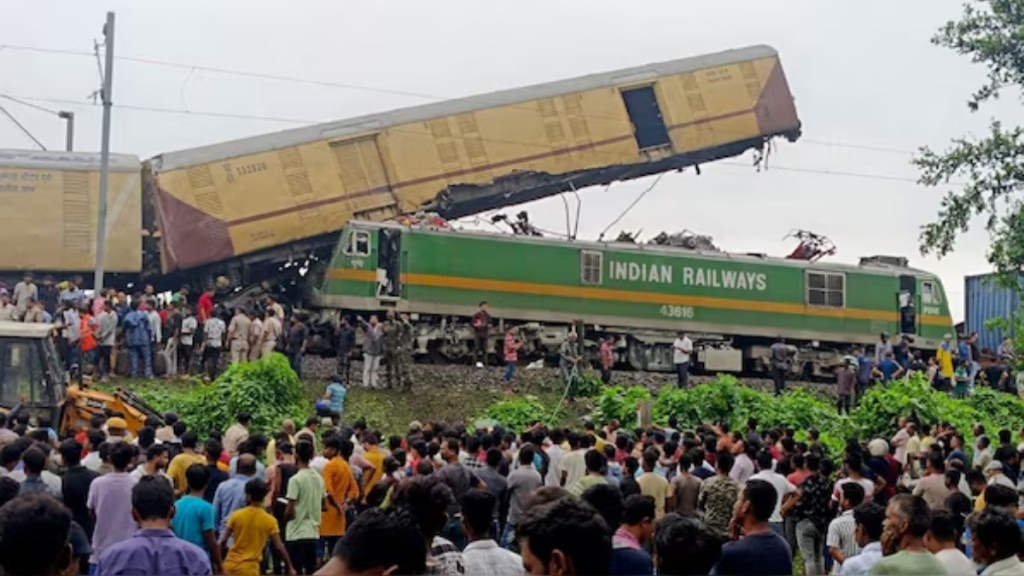The accident in West Bengal involving two trains has again brought to the fore the need to deploy the anti-train collision system, Kavach, across Indian Railways’ entire network. Banasree Purkayastha delves into the causes behind the delay in deployment and the need to prioritise rail safety
l How did the accident happen
ON JUNE 17, A goods train rammed into the rear end of the Sealdah-bound Kanchanjunga Express in north Bengal leading to the death of at least 10 people and leaving 25 injured. Three rear compartments derailed under the impact of the collision near Rangapani station, about 30 km from north Bengal’s New Jalpaiguri station. While initial reports said it was human error on the part of the loco pilot of the goods train, documents accessed by The Indian Express show that the automatic signalling system on the line was down since morning and the train was given ‘paper line clearance’ by the station manager to cross all red signals. The Kanchanjunga Express had departed from Rangapani station and stopped ahead on the same track due to the automatic signalling failure.
While the Commissioner of Railway Safety (CRS) for Northeast Frontier Railway has started a probe into the cause of the accident, the incident brought rail safety back into the debate and why the Indian Railways’ much-touted anti-train collision system, Kavach, had not been deployed in West Bengal.
l Patchy record of rail safety
EXPERTS SAY DEPLOYMENT of Kavach can help prevent train collisions, the second largest cause of train accidents in India after derailments. A year ago, on June 2, the Coromandel Express hit a goods train in Balasore in Odisha after hitting the Bengaluru-Howrah Superfast Express, resulting in a triple train crash that left nearly 300 people dead and over 1,000 injured. In October 2023, two trains collided in Andhra Pradesh’s Vizianagaram leaving 13 dead and 50 injured. There have been 18 collisions in the last 64 months leading to a consequential train accident (one that causes deaths, injuries, rail traffic disruption and damage to railway property), making modernisation of rail signaling systems a top priority.
l How Kavach prevents a collision
KAVACH, UNVEILED IN 2022, is an automatic train protection system developed by the Research Design and Standards Organisation of the Indian Railways. It transmits emergency messages and offers centralised live monitoring of train movements through the Network Monitor System. It is designed to give warnings to the loco pilot in case of overspeeding or in adverse weather conditions such as dense fog. If the pilot does not slow down below 15 km per hour on receiving the warnings, the Kavach system automatically applies brakes to bring the train to a halt. It has been designated as India’s National Automatic Train Protection (ATP) System. Based on Radio Frequency Identification (RFID) technology, the system comprises five key components: optical fibre work, towers to catch the signals, data centres at railway stations, trackside equipment and loco Kavach.
l Routes where it has been deployed
INDIAN RAILWAYS HAS deployed Kavach only on 1,465 km and 139 locomotives (including Electric Multiple Unit rakes) on South Central Railway. Contracts for another 3,000 km across Eastern Railway, East Central Railway, North Central Railway, Northern Railway, West Central Railway and Western Railway have been awarded for the Delhi-Mumbai (including Ahmedabad-Vadodara section) and Delhi-Howrah (including Lucknow-Kanpur section) routes. Following the accident, Railway Board chairman and CEO Jaya Varma Sinha said Kavach will be deployed on the Delhi-Guwahati route soon. She said it is in the railways’ next plan to cover over 6,000 km of tracks by next year while West Bengal falls within the 3,000 km to be protected by Kavach this year. The cost for trackside, including station equipment, of Kavach is about Rs 50 lakh per km while it costs Rs 70 lakh to install Kavach equipment in one loco. Over Rs 557 crore had been earmarked in the FY25 Interim Budget for Kavach implementation.
l Speeding up the installation process
INDIAN RAILWAYS IS likely to float tenders worth Rs 5000 crore in the next few months for installation of Kavach across 10,000 km. “Tenders for commissioning Kavach on close to 10,000 km of railway network is proposed to be initiated soon. The system, which has received a patent, has been approved for commissioning by additional vendors, including MNCs such as Japanese firm Kyosan. This will allow faster rollout of the system,” Mint quoted railway minister Ashwini Vaishnaw as saying. In February this year, he had said there are currently three Kavach manufacturers — HBL Power Systems, Kernex Microsystems, and Medha Servo Drives — with approval pending for two more. Due to the critical nature of the safety system, the approval process for manufacturers typically takes two-and-a-half years.
Recently, Indian Railways finalised an agreement with RailTel Corporation and Quadrant Future Tek to expedite the rollout of Kavach, both domestically and internationally.
